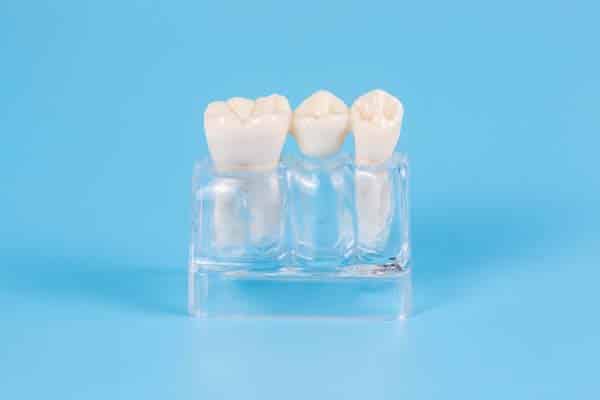
How Long Do Porcelain Bridges Last? Maintenance and Care Tips
Are you considering porcelain bridges to replace missing teeth but wondering how long they will last? You’re not alone. Porcelain bridges are an excellent investment in your dental health, but like any other dental restoration, they require proper care and maintenance. In this blog post, we’ll explore the lifespan of porcelain bridges and some helpful tips on keeping them lasting for years to come. So sit tight and let’s dive into everything you need to know about porcelain bridge longevity!
Porcelain bridges are a type of dental prosthesis used to replace one or more missing teeth. They are made of ceramic material and are attached to the adjacent teeth, known as abutment teeth. Bridges can be supported by natural teeth, implants, or a combination of both.
Porcelain bridges are an esthetic option for tooth replacement and can be matched to the color of your natural teeth. They are also strong and durable, making them a good choice for people who have healthy teeth and gums. However, porcelain bridges require proper maintenance and care in order to last long. Below are some tips on how to care for your porcelain bridge:
-Brush your teeth twice a day with a soft-bristled toothbrush and nonabrasive toothpaste. Be sure to brush gently around the base of the bridge where it meets the gum line.
-Floss daily using an interdental brush or floss threader to reach under the bridge and clean around the abutment teeth.
-Visit your dentist regularly for professional cleanings and checkups. Your dentist will also check for any signs of decay or other problems with your bridge or abutment teeth.

Benefits of Porcelain Bridges
Porcelain bridges are an excellent way to replace one or more missing teeth. They are durable, look natural, and can last for many years with proper care.
There are many benefits of porcelain bridges, including:
1. Improving the appearance of your smile – Porcelain bridges can give you back your confidence by restoring your smile. Missing teeth can make you feel self-conscious and affect the way you interact with others.
2. Maintaining the shape of your face – When you lose teeth, it can cause your face to sag and make you look older than you are. Porcelain bridges help to support the structure of your face and prevent further aging.
3. Improving your oral health – Bridges make it easier to eat and speak properly, which can improve your overall oral health. They also help to keep your remaining teeth in place by filling the gap left by a missing tooth/teeth.
How Long Do Porcelain Bridges Last?
Porcelain bridges are a popular choice for replacing missing teeth. They are made to match the color of your natural teeth and can last for many years with proper care.
While porcelain bridges typically last much longer than other types of dental bridges, their lifespan can vary depending on the individual. Some people may only get 10 years out of their porcelain bridge, while others may get 20 years or more.
The best way to prolong the life of your porcelain bridge is to practice good oral hygiene habits and visit your dentist regularly for checkups and cleanings. Be sure to brush twice a day, floss daily, and use mouthwash to keep your mouth free of bacteria. It’s also important to avoid habits that can damage your teeth, such as biting your nails or chewing on hard objects.
If you take care of your porcelain bridge, it should last you for many years to come!
Types of Maintenance and Care for Porcelain Bridges
Porcelain bridges are a type of dental prosthesis used to replace one or more missing teeth. As with any prosthetic device, porcelain bridges require regular maintenance and care in order to prolong their lifespan and function.
The three main types of porcelain bridges are:
1. Traditional/fixed bridges – These bridges are cemented into place and can only be removed by a dentist. Traditional bridges are the most common type of porcelain bridge.
2. Maryland Bridges – Also known as resin-bonded bridges, these devices consist of a metal framework with pontics (artificial tooth replacements) made of porcelain bonded to the framework. Maryland bridges are less invasive to place than traditional fixed bridges and they can be removed by the patient for cleaning.
3. Implant-supported bridges – As the name suggests, these types of bridges are supported by dental implants that are surgically placed in the jawbone. Implant-supported bridges tend to be more expensive than traditional or Maryland bridges but they offer a more permanent solution for tooth replacement.
No matter which type of porcelain bridge you have, it is important to practice good oral hygiene habits such as brushing twice a day, flossing daily, and using mouthwash. It is also important to visit your dentist regularly for professional cleanings and checkups so that any problems with your bridge can be detected and treated early on.

Tips for Best Results
Porcelain bridges are an excellent way to restore your smile if you have one or more missing teeth. But like all dental prosthetics, they require some care and maintenance to keep them looking their best and functioning properly. Here are some tips for getting the most out of your porcelain bridge:
-Be sure to brush and floss regularly, paying special attention to the area around the bridge. Plaque and tartar can build up around the base of the bridge and cause decay.
-See your dentist for regular checkups and cleanings. Your dentist can spot any potential problems with your bridge early on and take steps to prevent them from getting worse.
-Avoid chewing hard foods or using your teeth as tools (e.g., opening bottles, biting nails). This can damage the bridge or loosen it from its anchors.
-Wear a mouthguard if you play sports or grind your teeth at night. This will help protect your investment!

Alternatives to Porcelain Bridges
Porcelain bridges are not the only option available to patients looking to replace missing teeth. There are several alternatives to porcelain bridges that can be just as effective in restoring your smile.
Dental implants are one popular alternative to porcelain bridges. Dental implants are titanium posts that are surgically placed into the jawbone to serve as replacements for natural teeth. Once the implants have healed, artificial teeth can be attached to them, providing a sturdy and long-lasting solution for missing teeth.
Another alternative to porcelain bridges is dentures. Dentures are removable prosthetic devices that can replace all of the teeth in the upper or lower jaw or just some of them. Dentures are usually made of acrylic or metal and can be custom-fit to your mouth for a comfortable and natural-looking fit.
Finally, there is also the option of getting a traditional bridge. Traditional bridges involve placing artificial teeth (known as pontics) on top of supporting crowns that are bonded to adjacent natural teeth. Traditional bridges can be made from a variety of materials, including gold, porcelain, or a combination of both.
No matter which treatment you choose, it’s important to talk to your dentist about what will work best for you and your smile.
Conclusion
Porcelain bridges are an excellent option for replacing missing teeth. With proper care and maintenance, these bridges can last up to 15 years or more. When caring for porcelain bridges, it is important to practice good oral hygiene habits such as brushing twice a day, flossing daily, and avoiding staining foods like coffee and tea. Regular dental checkups with your dentist are also essential for the longevity of your porcelain bridge. By following these tips and taking good care of your porcelain bridge you can ensure that it lasts long into the future!
Porcelain bridges can last for many years, but it is important to take good care of them to ensure their longevity. Regular brushing and flossing, as well as visits to the dentist, will help keep your porcelain bridge in good condition.
To keep your porcelain bridge looking its best, brush twice daily and floss once daily. Be sure to use a soft-bristled toothbrush and gentle flossing motions. Additionally, avoid using harsh cleaners or abrasives on your porcelain bridge.


